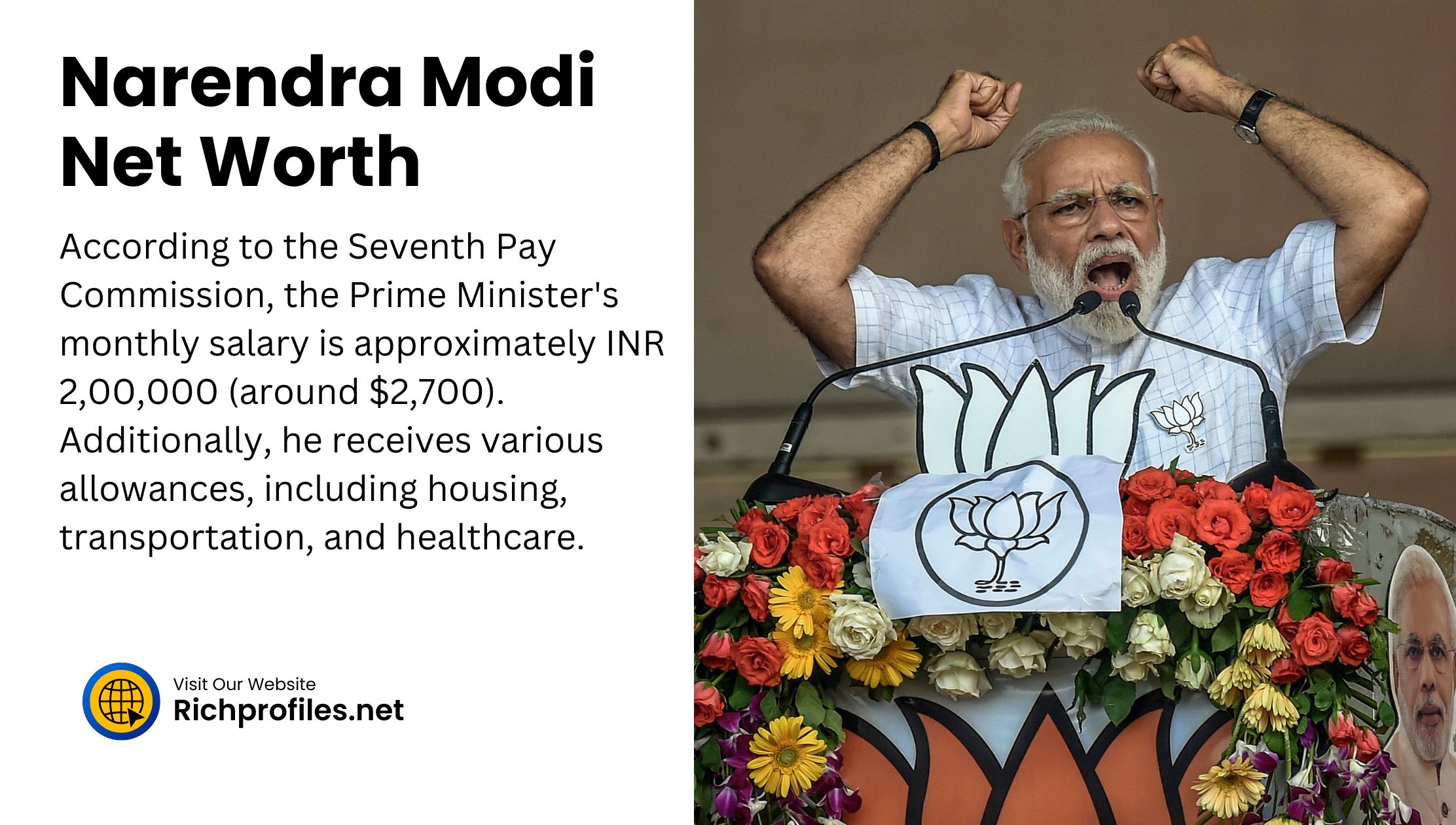Unveiling Narendra Modi Net Worth, Life and Career: A Comprehensive Analysis
In the realm of global politics, few figures stand as prominently as Narendra Modi, India’s current Prime Minister. With his rise to political prominence and continued leadership, many have shown a keen interest in understanding the financial aspects of his journey. Specifically, what is Narendra Modi net worth? This blog post aims to provide an in-depth analysis of his financial status, offering valuable insights for political enthusiasts and finance experts alike.
Early Life and Background
Narendra Damodardas Modi was born on September 17, 1950, in Vadnagar, a small town in the Mehsana district of Gujarat, India. Born into a family of modest means, Modi’s early life was marked by hard work and perseverance. His father, Damodardas Mulchand Modi, ran a tea stall, where young Narendra often assisted, a story that has become emblematic of his humble roots and work ethic.
Rise Through the Ranks
Modi’s political career began with his association with the Rashtriya Swayamsevak Sangh (RSS), a Hindu nationalist organization. He joined the RSS as a pracharak (campaigner) in the early 1970s, a period during which he honed his organizational skills and ideological grounding.
Gujarat Chief Minister
In 2001, Modi was appointed as the Chief Minister of Gujarat, succeeding Keshubhai Patel. His tenure as Chief Minister is often cited for its focus on economic development and modernization. However, it was also marred by the 2002 Gujarat riots, a tragic event that remains a controversial chapter in his career.
Economic Development
Under Modi’s leadership, Gujarat experienced significant industrial growth and infrastructural development. His policies aimed at improving the business climate, attracting investment, and building robust public infrastructure are often credited with transforming Gujarat into an economic powerhouse.
National Political Ascent
Modi’s administrative success in Gujarat set the stage for his entry into national politics. His image as a development-oriented leader resonated with the electorate, leading to his selection as the Prime Ministerial candidate for the Bharatiya Janata Party (BJP) in the 2014 general elections.
2014 General Elections
The 2014 elections were a turning point in Indian politics. Modi campaigned on promises of economic revival, corruption eradication, and good governance. The BJP secured a landslide victory, winning 282 out of 543 seats in the Lok Sabha, India’s lower house of Parliament. Modi was sworn in as the Prime Minister on May 26, 2014.
Key Policies and Initiatives
Since taking office, Modi has implemented several key policies aimed at transforming India’s socio-economic landscape.
Make in India
Launched in 2014, the “Make in India” initiative aims to position India as a global manufacturing hub. The policy focuses on 25 sectors, including automobiles, textiles, and electronics, and encourages domestic and foreign investment.
Digital India
The “Digital India” initiative, also launched in 2014, aims to ensure that government services are made available to citizens electronically by improving online infrastructure and increasing internet connectivity. This initiative has played a crucial role in promoting digital literacy and bridging the digital divide.
Swachh Bharat Abhiyan
The “Swachh Bharat Abhiyan” (Clean India Mission) is a nationwide campaign launched in 2014 with the goal of achieving universal sanitation coverage. The mission has led to the construction of millions of toilets across urban and rural India, significantly improving public health and hygiene.
Goods and Services Tax (GST)
In 2017, Modi’s government implemented the Goods and Services Tax (GST), one of the most significant tax reforms in Indian history. GST replaced multiple indirect taxes with a single, unified tax structure, simplifying the tax system and fostering a unified national market.
Read More: Barack Obama Net Worth
Global Statesman
Modi’s impact extends beyond India’s borders. His foreign policy approach, often referred to as the “Modi Doctrine,” emphasizes stronger ties with neighboring countries, strategic partnerships with global powers, and active participation in international forums.
Strengthening Bilateral Relations
Modi has sought to strengthen India’s bilateral relations with countries like the United States, Japan, and Israel. His visits to these nations and engagement with their leaders have led to increased cooperation in areas such as defense, technology, and trade.
Act East Policy
Modi has reinvigorated India’s “Look East Policy,” renaming it the “Act East Policy.” This policy aims to enhance India’s engagement with Southeast Asian nations, focusing on economic, strategic, and cultural ties. It underscores India’s commitment to playing a more prominent role in the Asia-Pacific region.
Climate Leadership
Under Modi’s leadership, India has taken significant steps towards addressing climate change. The International Solar Alliance (ISA), co-founded by India and France, aims to promote solar energy and sustainable development worldwide. Modi’s commitment to renewable energy has positioned India as a global leader in the fight against climate change.
The Components of Narendra Modi’s Net Worth
Narendra Modi’s net worth is composed of several elements, including his salary, assets, and investments. As of the latest available data, here is a breakdown of these components:
1. Salary and Allowances
As the Prime Minister of India, Narendra Modi draws a salary and various allowances as per the Indian government’s regulations. According to the Seventh Pay Commission, the Prime Minister’s monthly salary is approximately INR 2,00,000 (around $2,700). Additionally, he receives various allowances, including housing, transportation, and healthcare.
2. Personal Assets
Narendra Modi’s personal assets include immovable and movable properties. These assets are declared periodically as part of mandatory disclosures. As of the latest declaration, some of his notable assets include:
- Residential Property: Modi owns a modest residential property in Gandhinagar, Gujarat. The property is valued at approximately INR 1.1 crore (around $150,000).
- Bank Deposits: Modi has multiple bank accounts with a total balance of around INR 2 lakh (around $2,700).
- Jewelry: He owns a few pieces of gold jewelry, valued at approximately INR 1.5 lakh (around $2,000).
3. Investments
Narendra Modi’s investment portfolio is relatively conservative. He has invested in government savings schemes, national bonds, and insurance policies. These investments collectively add to his net worth and ensure financial security for his future.
Analyzing Modi’s Financial Transparency
One of the remarkable aspects of Narendra Modi’s financial profile is his commitment to transparency. Unlike many political figures worldwide, Modi has consistently declared his assets and liabilities publicly. This transparency not only reflects his adherence to ethical standards but also builds trust among the citizens of India.
Comparing Modi’s Net Worth with Other World Leaders
To provide a holistic view, it’s interesting to compare Narendra Modi’s net worth with that of other world leaders. Here are a few examples:
1. Joe Biden (United States)
As of 2021, the net worth of Joe Biden, President of the United States, is estimated to be around $9 million. This includes his earnings from book deals, speaking engagements, and his vice-presidential pension.
2. Angela Merkel (Germany)
Angela Merkel, the former Chancellor of Germany, has an estimated net worth of around $11.5 million. Her wealth primarily comes from her salary as Chancellor and investments.
3. Justin Trudeau (Canada)
Justin Trudeau, the Prime Minister of Canada, has an estimated net worth of approximately $10 million. His wealth is attributed to his inheritance, salary, and investments.
The Impact of Modi’s Economic Policies on His Net Worth
Narendra Modi’s tenure as Prime Minister has seen significant economic reforms and initiatives. While these policies primarily aim to boost India’s economy, they indirectly impact his net worth as well. Some notable initiatives include:
1. Demonetization
In 2016, Modi announced the demonetization of high-value currency notes, which aimed to curb black money and promote digital transactions. This move had a profound impact on the Indian economy and financial markets.
2. Goods and Services Tax (GST)
The introduction of GST in 2017 streamlined India’s tax system and boosted revenue collection. This reform has had a positive impact on the overall economy.
3. Atmanirbhar Bharat (Self-Reliant India)
Modi’s vision of a self-reliant India focuses on promoting domestic manufacturing and reducing dependence on imports. This initiative has the potential to drive economic growth and create job opportunities.
Conclusion
Narendra Modi’s net worth, while modest compared to many other global leaders, reflects his commitment to transparency and ethical governance. His financial journey is intertwined with his political career and the economic policies he has championed. For political enthusiasts and finance experts, understanding Modi’s net worth offers valuable insights into the financial aspects of political leadership.
As we continue to witness his leadership, it will be interesting to see how his net worth evolves and what new financial disclosures emerge. Stay tuned for more updates on Narendra Modi’s financial journey and its implications for India’s future.

